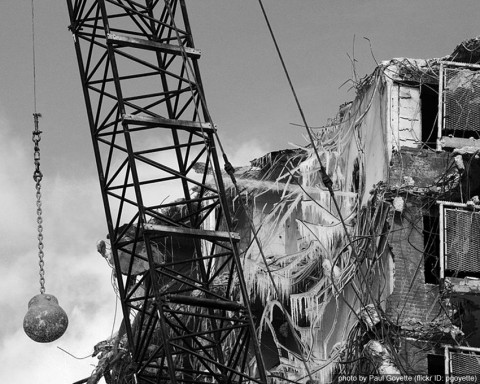NYU Gallatin student and Urban Democracy Lab blog manager Kai Bauer reviews the event, “Landscapes of Creative Destruction: Regenerating the Postindustrial City,” hosted by Deutsches Haus NYU and the Urban Democracy Lab on April 16th, 2016.
The Landscapes of Creative Destruction: Regenerating the Postindustrial City event encompassed various attitudes and imaginings of the collective urban future. Boris Vormann, professor of political science and urban political economy at Freie Universität’s John F. Kennedy Institute for North American Studies, began by expanding the understanding of the postindustrial city and its reality. He argued that while postindustrial cities are “harbingers of a better urban future,” the reality is that we do not live in a postindustrial era. The “corrupt, criminal, urban past of the industrial era” still plagues us, said Vormann. While certain individual areas may seem to make post-industrialism viable, the reality is that the supply chain is just longer and the industry is invisibilized—not eliminated. The industry still takes place in undemocratic and polluted countries like China, which allows urban areas like “the waterfront” to imagine themselves as postindustrial while still being a part of the system. In fact, Vormann stated, manufacturing labor has doubled and we are actually in a “hyper-industrial era.” Vormann implores us to overcome this “myopic lens” on the city and focus on a more holistic, global scale.
Vormann explained that to fully remedy the problems of uneven development, the discourse must shift from economic to political considerations. The state is “at every corner” in labor, transport, and technology and therefore must be acknowledged and held accountable for the resulting market. The economy does not simply ebb and flow without any control. If the state does not intervene, industry can simply shift away from the city and continue in a dangerous and unregulated nature. In short, according to Vormann, we are not moving forward, but are spatially shifting the negative from view and the state is therefore complicit in creating a better urban industrial future.
Robert Elmes, a businessman and the Executive Director of Galapagos Art Space in Detroit, explained how he and his colleagues have created better urban futures for themselves already. His art space was initially housed in New York and claims to have “distilled the Williamsburg ethos into a single idea,” which ended up being so powerful that it attracted thousands of artist group participants to Brooklyn. The group then capitalized on the burgeoning success of areas like Williamsburg by parlaying into real estate investments and projects. After a “rebranding move” to Dumbo, Elmes’ artist group was eventually pushed out of the Brooklyn area due to high rent prices. Elmes then moved to what he calls the “affordable cultural habitat” of Detroit. Elmes believes that if “everyone can own their home, then everyone can rise” and explains that for people moving to Detroit, homes can be incredibly inexpensive. He did not address how people already living there can rise, but does reiterate that this is a better urban future for the people moving there. He also did not address the fact that his group seems to have gentrified themselves out of Brooklyn, and then are again participating in real estate development in Detroit that will raise prices and displace others and maybe even themselves.
Finally Eve Baron, Academic Program Manager at The Murphy Institute at CUNY School of Professional Studies and Consultant for Urban Planning and Policy Analysis at The Collective for Community, Culture, and the Environment, discussed post-industrialism and its relationship with race, class, and industry. 15% of New York City is still industrially zoned and these areas are often found adjacent to poor communities that are often Black, Latino, or Asian. Environmental burdens like brownfields or hazardous waste disposal sites are usually found near these poor, industrial pockets. Baron asked who is post-industrialism for, because many people are struggling with the “industrial present.” By looking at New York City through a postindustrial lens, there is harmful erasure of the current organizing that is happening around environmental and economic justice issues, according to Baron. She emphasized that industrially-impacted communities should not only have a seat at the table, but also “lead the conversation.”
The Landscapes of Creative Destruction panel offered a multitude of varying viewpoints that explored the many ways we interact in a postindustrial urban present, and whether we are even in a postindustrial state at all. By understanding spatial industrial realities, the boundaries of real estate ownership, and equitability in industrial areas, the panel retooled and reexamined what composes our economy and our urban futures.

